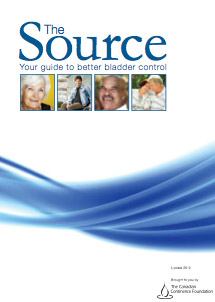"The Source" Guide
Click on the image of the guide below to download your own copy.
“The Source”: Your Guide to Better Bladder Control

In the following pages, you’ll learn everything you need to know about incontinence: the signs and symptoms of each type of incontinence; how it’s diagnosed; and, most important, how to make it better. You’ll learn that incontinence is not a disease; it’s a sign that something else in the body is wrong. We’ve included checklists and charts that you can fill out before you meet with your doctor, to help him or her understand your symptoms and zero in on a plan of action.
Click here to get your own PDF copy of 'The Source'.
Click here to get your own MOBI copy of 'The Source'.
MOBI files are optimized for tablets and e-readers.
For our male readers, the “Men’s Room” — a recurring section you’ll find throughout the guide — focuses on important topics that apply specifically to men who suffer from incontinence. Finally, we’ve created a special section on fecal incontinence, a less common though no less devastating condition that ranges from occasional leakage to complete loss of bowel control.
Newer OAB medications not found in The Source –
Mirabegron (Myrbetriq)
Mirabegron is a new drug for the treatment of OAB which acts in a different way to the others. It acts on a different chemical receptor (the beta-3- receptor) in the bladder which causes relaxation of the bladder whilst it fills. This action is associated with a reduction in urinary urgency, frequency and urgency incontinence. Mirabegron is licensed for use in a 25mg and 50mg dose. Clinicians vary as to the way in which they use the drug as the effect is not always dose dependent. Its side effect profile is different from the other drugs and includes urinary tract infection and a raised pulse rate, although the significance of these is not clear. Mirabegron has been shown to be effective and safe in older people with OAB. Applications for formal reimbursement on provincial drug programs are in process.
Fesoterodine (Toviaz)
Fesoterodine is a medication which is converted into the same chemical as tolterodine is converted into by the body, but in a more dependable fashion. It is available in 4 and 8 mg doses and has been shown to be effective in the treatment of OAB against placebo and 8mg of fesoterodine is superior to 4mg of tolterodine. Fesoterodine has been extensively tested in older people and has proven effective and safe with no unexpected problems. Anticholinergic side effects may limit adherence. Fesoterodine is included in the majority of provincial drug programs.
Propiverine hydrochloride (Mictoryl®/Mictoryl® Pediatric)
Propiverine hydrochloride is a molecule newly introduced in Canada. Propiverine hydrochloride is used for the treatment of overactive bladder (OAB) and has been widely studied in Europe, where its safety and efficacy have been well established through clinical experience. Propiverine hydrochloride provides an additional treatment option for Canadian patients. In addition to its adult indication, propiverine hydrochloride has also been studied in children and has an indication for children (5 years and older). Propiverine hydrochloride is also indicated for patients over the age of 65. It is available in 30 and 45 mg modified-release capsules for adults and in 5 mg immediate-release tablets with a weight-adjusted dosing for children. The most common adverse reactions reported in patients treated with propiverine hydrochloride include dry mouth, headache, accommodation disorder, visual impairment, constipation, abdominal pain, dyspepsia and fatigue.






